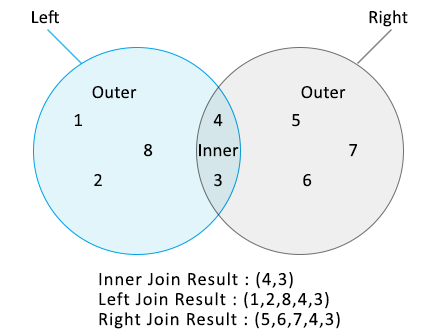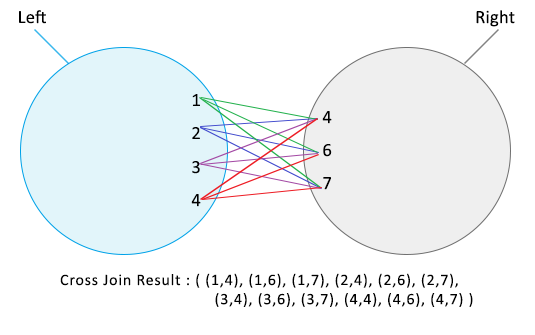Types Of joins in LINQ with C#
There are Different Types of SQL
Joins are used to query data from more than one
database table. In this article, you will learn about how to write SQL joins
queries in LINQ using
C#. LINQ has a JOIN query operator that gives you SQL JOIN like behavior and syntax.
diagram for LINQ Joins


Inner Join:
"Inner Join returns only matching rows in the result set form 2 or more collection."
For Example, If you have 2 collections, and you want to perform an inner join, then only matching elements between two collections are included in the result set.
Non-matching rows Excluded from the result set.
Let's understand Inner Join with an example. Consider the following Department and Employee classes. Notice that, Employee Andy does not have a department assigned. An inner join will not include his record in the result set.
public class Department
{
public int ID { get; set; }
public string Name { get; set; }
public static List<Department> GetAllDepartments()
{
return new List<Department>()
{
new Department { ID = 1, Name = "IT"},
new Department { ID = 2, Name = "HR"},
new Department { ID = 3, Name = "Payroll"},
};
}
}
public class Employee
{
public int ID { get; set; }
public string Name { get; set; }
public int DepartmentID { get; set; }
public static List<Employee> GetAllEmployees()
{
return new List<Employee>()
{
new Employee { ID = 1, Name = "Mark", DepartmentID = 1 },
new Employee { ID = 2, Name = "Steve", DepartmentID = 2 },
new Employee { ID = 3, Name = "Ben", DepartmentID = 1 },
new Employee { ID = 4, Name = "Philip", DepartmentID = 1 },
new Employee { ID = 5, Name = "Mary", DepartmentID = 2 },
new Employee { ID = 6, Name = "Valarie", DepartmentID = 2 },
new Employee { ID = 7, Name = "John", DepartmentID = 1 },
new Employee { ID = 8, Name = "Pam", DepartmentID = 1 },
new Employee { ID = 9, Name = "Stacey", DepartmentID = 2 },
new Employee { ID = 10, Name = "Andy"}
};
}
}
Example 1 : Join the Employees and Department collections and print all the Employees and their respective department names.
var result = Employee.GetAllEmployees().Join(Department.GetAllDepartments(),
e => e.DepartmentID,
d => d.ID, (employee, department) => new
{
EmployeeName = employee.Name,
DepartmentName = department.Name
});
foreach (var employee in result)
{
Console.WriteLine(employee.EmployeeName + "\t" + employee.DepartmentName);
}
Output: Notice that, in the output we don't have Andy record. This is because, Andy does not have a matching department in Department collection. So this is effectively an inner join.

Example 2 : Rewrite Example 1 using SQL like syntax.
var result = from e in Employee.GetAllEmployees()
join d in Department.GetAllDepartments()
on e.DepartmentID equals d.ID
select new
{
EmployeeName = e.Name,
DepartmentName = d.Name
};
foreach (var employee in result)
{
Console.WriteLine(employee.EmployeeName + "\t" + employee.DepartmentName);
}
Group JOIN
Group Join produces hierarchical data structures. Each element from the first collection is paired with a set of correlated elements from the second collection.
Let us understand Group Join with an example. Consider the following Department and Employee classes. A Department may have ZERO or MORE employees.
Example 1: Group employees by Department.
Output:

Example 2: Rewrite Example 1 using SQL like syntax.
Please note: Group Join uses the join operator and the into keyword to group the results of the join.
public class Department
{
public int ID { get; set; }
public string Name { get; set; }
public static List<Department> GetAllDepartments()
{
return new List<Department>()
{
new Department { ID = 1, Name = "IT"},
new Department { ID = 2, Name = "HR"},
new Department { ID = 3, Name = "Payroll"},
};
}
}
public class Employee
{
public int ID { get; set; }
public string Name { get; set; }
public int DepartmentID { get; set; }
public static List<Employee> GetAllEmployees()
{
return new List<Employee>()
{
new Employee { ID = 1, Name = "Mark", DepartmentID = 1 },
new Employee { ID = 2, Name = "Steve", DepartmentID = 2 },
new Employee { ID = 3, Name = "Ben", DepartmentID = 1 },
new Employee { ID = 4, Name = "Philip", DepartmentID = 1 },
new Employee { ID = 5, Name = "Mary", DepartmentID = 2 },
new Employee { ID = 6, Name = "Valarie", DepartmentID = 2 },
new Employee { ID = 7, Name = "John", DepartmentID = 1 },
new Employee { ID = 8, Name = "Pam", DepartmentID = 1 },
new Employee { ID = 9, Name = "Stacey", DepartmentID = 2 },
new Employee { ID = 10, Name = "Andy", DepartmentID = 1}
};
}
}
Example 1: Group employees by Department.
var employeesByDepartment = Department.GetAllDepartments()
.GroupJoin(Employee.GetAllEmployees(),
d => d.ID,
e => e.DepartmentID,
(department, employees) => new
{
Department = department,
Employees = employees
});
foreach (var department in employeesByDepartment)
{
Console.WriteLine(department.Department.Name);
foreach (var employee in department.Employees)
{
Console.WriteLine(" " + employee.Name);
}
Console.WriteLine();
}
Output:

Example 2: Rewrite Example 1 using SQL like syntax.
var employeesByDepartment = from d in Department.GetAllDepartments()
join e in Employee.GetAllEmployees()
on d.ID equals e.DepartmentID into eGroup
select new
{
Department = d,
Employees = eGroup
};
Please note: Group Join uses the join operator and the into keyword to group the results of the join.
LEFT JOIN: All the matching elements + all the non-matching elements from the left collection are included in the result set.
Let us understand implementing Left Outer Join with an example. Consider the following Department and Employee classes. Notice that, Employee Mary does not have a department assigned. An inner join will not include her record in the result set, where as a Left Outer Join will.
Use DefaultIfEmpty() method on the results of a group join to implement Left Outer Join
Example 1 : Implement a Left Outer Join between Employees and Department collections and print all the Employees and their respective department names. Employees without a department, should display "No Department" against their name.
Output: Notice that, we also have Mary record in spite of she not having a department. So this is effectively a left outer join.

Example 2 : Rewrite Example 1 using extension method syntax.
To implement Left Outer Join, with extension method syntax we use the GroupJoin() method along with SelectMany() and DefaultIfEmpty() methods.
public class Department
{
public int ID { get; set; }
public string Name { get; set; }
public static List<Department> GetAllDepartments()
{
return new List<Department>()
{
new Department { ID = 1, Name = "IT"},
new Department { ID = 2, Name = "HR"},
};
}
}
public class Employee
{
public int ID { get; set; }
public string Name { get; set; }
public int DepartmentID { get; set; }
public static List<Employee> GetAllEmployees()
{
return new List<Employee>()
{
new Employee { ID = 1, Name = "Mark", DepartmentID = 1 },
new Employee { ID = 2, Name = "Steve", DepartmentID = 2 },
new Employee { ID = 3, Name = "Ben", DepartmentID = 1 },
new Employee { ID = 4, Name = "Philip", DepartmentID = 1 },
new Employee { ID = 5, Name = "Mary" }
};
}
}
Use DefaultIfEmpty() method on the results of a group join to implement Left Outer Join
Example 1 : Implement a Left Outer Join between Employees and Department collections and print all the Employees and their respective department names. Employees without a department, should display "No Department" against their name.
var result = from e in Employee.GetAllEmployees()
join d in Department.GetAllDepartments()
on e.DepartmentID equals d.ID into eGroup
from d in eGroup.DefaultIfEmpty()
select new
{
EmployeeName = e.Name,
DepartmentName = d == null ? "No Department" : d.Name
};
foreach (var v in result)
{
Console.WriteLine(v.EmployeeName + "\t" + v.DepartmentName);
}
Output: Notice that, we also have Mary record in spite of she not having a department. So this is effectively a left outer join.

Example 2 : Rewrite Example 1 using extension method syntax.
var result = Employee.GetAllEmployees()
.GroupJoin(Department.GetAllDepartments(),
e => e.DepartmentID,
d => d.ID,
(emp, depts) => new { emp, depts })
.SelectMany(z => z.depts.DefaultIfEmpty(),
(a, b) => new
{
EmployeeName = a.emp.Name,
DepartmentName = b == null ? "No Department" : b.Name
});
foreach (var v in result)
{
Console.WriteLine(" " + v.EmployeeName + "\t" + v.DepartmentName);
}
To implement Left Outer Join, with extension method syntax we use the GroupJoin() method along with SelectMany() and DefaultIfEmpty() methods.
Cross join produces a cartesian product i.e when we cross join two sequences, every element in the first collection is combined with every element in the second collection.
The total number of elements in the resultant sequence will always be equal to the product of the elements in the two source sequences. The on keyword that specfies the JOIN KEY is not required.
Let us understand implementing Cross Join with an example. Consider the following Department and Employee classes.
public class Department
{
public int ID { get; set; }
public string Name { get; set; }
public static List<Department> GetAllDepartments()
{
return new List<Department>()
{
new Department { ID = 1, Name = "IT"},
new Department { ID = 2, Name = "HR"},
};
}
}
public class Employee
{
public int ID { get; set; }
public string Name { get; set; }
public int DepartmentID { get; set; }
public static List<Employee> GetAllEmployees()
{
return new List<Employee>()
{
new Employee { ID = 1, Name = "Mark", DepartmentID = 1 },
new Employee { ID = 2, Name = "Steve", DepartmentID = 2 },
new Employee { ID = 3, Name = "Ben", DepartmentID = 1 },
new Employee { ID = 4, Name = "Philip", DepartmentID = 1 },
new Employee { ID = 5, Name = "Mary", DepartmentID = 2 },
};
}
}
Example 1 : Cross Join Employees collection with Departments collections.
var result = from e in Employee.GetAllEmployees()
from d in Department.GetAllDepartments()
select new { e, d };
foreach (var v in result)
{
Console.WriteLine(v.e.Name + "\t" + v.d.Name);
}
Output: We have 5 elements in Employees collection and 2 elements in Departments collection. In the result we have 10 elements, i.e the cartesian product of the elements present in Employees and Departments collection. Notice that every element from the Employees collection is combined with every element in the Departments collection.

Example 2 : Cross Join Departments collections with Employees collection
var result = from d in Department.GetAllDepartments()
from e in Employee.GetAllEmployees()
select new { e, d };
foreach (var v in result)
{
Console.WriteLine(v.e.Name + "\t" + v.d.Name);
}
Output: Notice that the output in this case is slightly different from Example 1. In this case, every element from the Departments collection is combined with every element in the Employees collection.

Example 3 : Rewrite Example 1 using extension method syntax
To implement Cross Join using extension method syntax, we could either use SelectMany() method or Join() method
Implementing cross join using SelectMany()
var result = Employee.GetAllEmployees()
.SelectMany(e => Department.GetAllDepartments(), (e, d) => new { e, d });
foreach (var v in result)
{
Console.WriteLine(v.e.Name + "\t" + v.d.Name);
}
Implementing cross join using Join()
var result = Employee.GetAllEmployees()
.Join(Department.GetAllDepartments(),
e => true,
d => true,
(e, d) => new { e, d });
foreach (var v in result)
{
Console.WriteLine(v.e.Name + "\t" + v.d.Name);
}





0 Comments